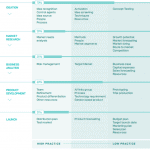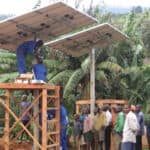From the Fringe to the Center: Assessing the State of the Off-Grid Appliance Market in 2020
Achieving energy access is about much more than connecting households to the grid, or getting them a rooftop solar panel. People need access to the appliances that can deliver life-changing services that reduce time spent on household chores, open up opportunities to generate income, and improve connectivity to their communities and the world. The typical household in rural sub-Saharan Africa owns two to five appliances, but it’s common for households in more developed countries to have 30 or more appliances. The figure below shows the discrepancy in common appliance penetration by region – and for households in rural sub-Saharan Africa (grid and off-grid), the percentages are even lower: 17% for TVs, 4% for refrigerators and between 6-8% for fans.
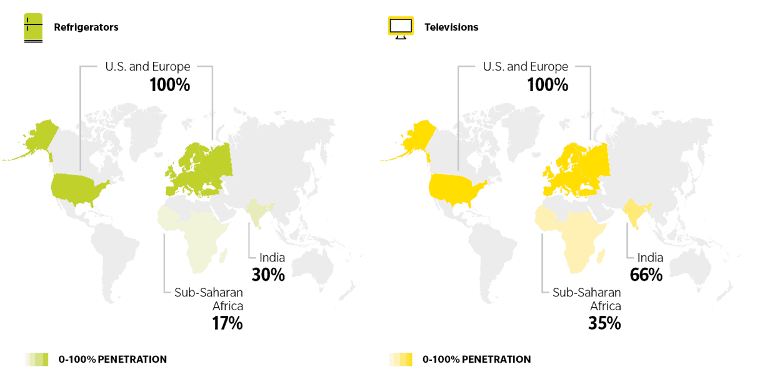
To better understand the market for appliances specifically designed for households that lack access to reliable grid power, CLASP and Dalberg published the first State of the Off-grid Appliance Market Report in 2016. This was the first comprehensive accounting of trends and opportunities in the nascent off-grid household appliance sector. At that time the market for off-grid lighting and solar home system was beginning to mature, and companies were looking for ways to add appliances to their offerings to improve the value they deliver to customers and ensure long-term profitability. This created an emerging class of fans, televisions and refrigerators that were designed specifically for off-grid customers—primarily living in rural Africa and South Asia.
Since that time, the sector has developed considerably. The recently released 2019 State of the Off-grid Appliance Market Report refreshes the market sizing, and provides deep insights into product and technology trends, consumer insights and supply chain dynamics.
Appliances: Moving From the Fringe to the Center of Energy Access
A few things stand out in an initial overview of the report: For starters, the number of companies engaging in the sector has grown significantly. In 2018, 34 members of the off-grid solar industry association GOGLA sold appliances or productive use technologies – but today, that number has more than doubled to 72. And it’s not just GOGLA members operating in this sector: We are aware of over 200 companies engaged in the supply or distribution of off-grid appliances, and established companies in the off-grid solar sector continue to add new appliances to their product lines. In 2018 GOGLA began collecting sales data for off-grid appliances, in partnership with the Efficiency for Access Coalition, and participating companies reported over one million products sold in the first 12 months of data collection.
In addition, it’s apparent that donors and investors who have supported off-grid solar and mini-grid electrification efforts are ramping up their support for off-grid appliances, which are critical to delivering the higher levels of energy service needed to capture the full socio-economic benefits of electrification. Much of this work is coordinated by the Efficiency for Access Coalition, which brings together 15 donors that support programs that aim to scale up markets and reduce prices for super-efficient off- and weak-grid-appropriate products, support technological innovation and improve sector coordination. Together, coalition members have invested over £100 million in programs and companies that are supporting the growth of this market. But much more is needed to achieve the economic empowerment and quality of life improvements that high-performing appliances enable.
Here are seven more key takeaways from the report we think all energy access stakeholders should know.
A Growing Market With Major Untapped Demand
The cumulative market opportunity across off-grid televisions, fans and refrigerators is estimated at US $12.6 billion globally. The market has the potential to double to US $25.3 billion by 2030, driven primarily by refrigerator and television demand. It is transforming from a sector primarily supported by public aid and philanthropy, to a market that is attracting investment and interest from private sector actors and large multinational companies. And since overall appliance penetration is low in off-grid markets, there is significant untapped demand.

A Range of Positive Impacts
Appliances have wide-ranging positive impacts on economic livelihoods, health and education. Refrigerators help address the food losses of 30% that exist in sub-Saharan Africa. Fans reduce mortality during heat waves and increase overall health and well-being in households. Televisions lead to improved educational outcomes and connect households to the broader world. A recent study from M-Kopa and CDC found that in Kenya, households saved an average of 480 Kenyan shillings and two hours of time after acquiring a refrigerator. In Uganda, revenue nearly doubled for entrepreneurs who had a refrigerator installed as part of a field test, and nearly half of customers expanded to a new product line. Televisions are not often associated with development impacts, but recent surveys found that 79% of off-grid television customers reported that the TV reduced their stress levels, and over 90% said it improved their general knowledge and political awareness.
Market Uptake of Off-Grid Appliances is Growing
There are significant data gaps, but we estimate 30-80% year-on-year market growth driven by technology advances, increased market entrants and competition. We estimate that there are 5-10 million off-grid TVs, refrigerators and fans on the market, but only a small share of these are branded – most are cheap products developed by Chinese manufacturers, which are often copycats or counterfeits with no options for customer service. As mentioned above, the appliance sales data being collected and reported by GOGLA and the Efficiency for Access Coalition is creating an important piece of market intelligence and allowing the sector to track growth.
Consumer Affordability and Access to Finance are Key Barriers to Market Growth
It’s estimated that there are 425 million off- and weak-grid households in South Asia and sub-Saharan Africa. Around half of those households could afford off-grid TVs and fans, and about 15% could afford a refrigerator with affordable consumer financing. However, when considering accessibility—the fact that customers must actually have access to finance, and distributors must be able to reach households physically to sell and service appliances—the size of the market drops to 39 million for fans, 36 million for TVs and 11 million for refrigerators. The takeaway: Financing is still critical to make the business model work. The figure below shows the share of households in key countries that are able to afford appliances, with and without financing.
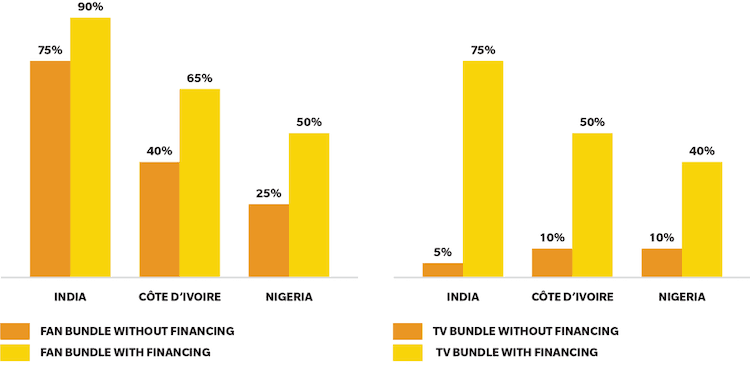
Needed: Innovations for Efficiency
There are strong incentives in the off-grid appliance sector to innovate on efficiency, because consumers see the savings up-front due to the reduction in the total cost of the system (i.e.: smaller solar panels and batteries are needed to achieve the same level of energy service from appliances.) The figure below shows that the number of solar panels and batteries needed can increase by a factor of eight if efficiency is not prioritized. Product development continues to balance efficiency innovations and affordability constraints, given the number of low-income customers. But we’re still seeing innovations and efficiency gains in the sector: For example the 2019 winners of the Global LEAP Off-grid Refrigerator Competition averaged 28% greater overall efficiency compared to 2017 Winners.
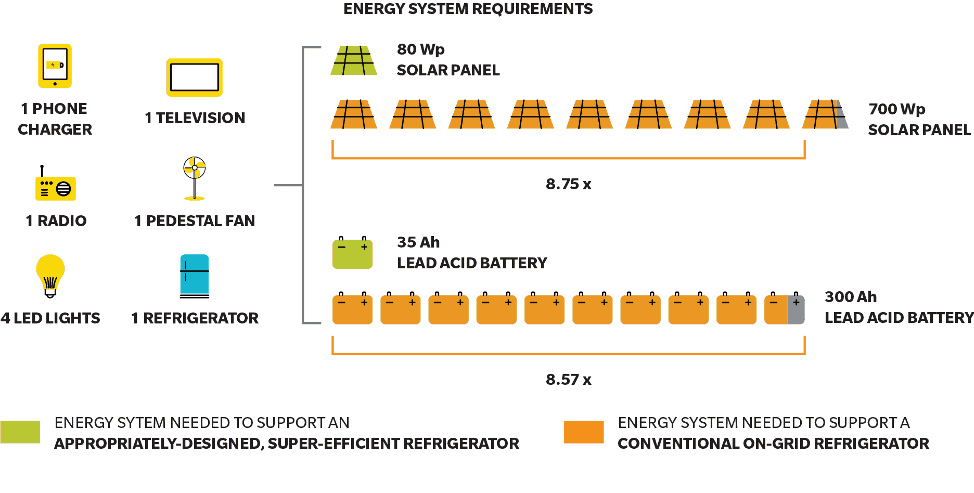
Large Appliances are Needed for Small Business
While smaller appliances such as fans and televisions are demanded for household use, larger, more expensive and energy-consuming appliances such as refrigerators and solar water pumps may be more suited to small business and agricultural use at this stage in the market.
Recommendations for Greater Sector Growth
The market fundamentals for off-grid appliances are sound, they just require the right encouragement and support. We recommend the following actions to continue to drive sector growth:
- Government policies should further recognize the importance of high-performing appliances in driving energy demand and achieving sustainable development goals, and integrate appliances into their national electrification initiatives.
- Financing of off- and weak-grid-appropriate appliances should continue to be supported by donors and impact investors. Even with business model innovation and falling technology costs, reaching scale will require consumer financing and concessionary debt and risk capital for innovators.
- Consumer protection should be a more prominent feature of off-grid appliance promotion initiatives among donors and sector intermediaries. This includes the development and dissemination of well-defined product quality standards, support for product testing and certification programs, and the adoption of warranties.
- Donors and other off-grid sector intermediaries should build multinational company and investor awareness around the large financial opportunity in appliances, and provide targeted market entry support. The potential of multi-national actors to bring in incremental research and development resources and manufacturing scale could be transformative for the sector.
As the nascent off-grid household appliance sector moves into its next phase, we hope these insights will help provide greater clarity about how the market developing, where innovation is needed, and how investors and others stakeholders can provide support. Check out the report and subscribe to the Efficiency for Access newsletter for more information.
Jenny Corry Smith is a Senior Manager at CLASP.
Michael Tsan is a Partner at Dalberg Advisors.
- Categories
- Energy
